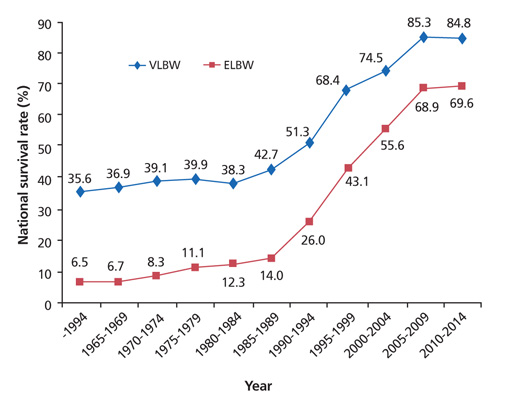J Korean Med Assoc.
2016 Jul;59(7):490-497. 10.5124/jkma.2016.59.7.490.
The history of neonatology in Korea
- Affiliations
-
- 1Department of Pediatrics, Kyung Hee University School of Medicine, Seoul, Korea. baecw@khnmc.or.kr
- KMID: 2343859
- DOI: http://doi.org/10.5124/jkma.2016.59.7.490
Abstract
- Neonatology in pediatrics became a part of medical school curricula in Korea in 1954-1959. Specific treatments and procedures in the neonatal field were adopted around this period, for example, antibiotics, oxygen therapy, and the exchange transfusion procedure were established in 1950-1960. Usage of an infant incubator was implemented along with the establishment in 1960. The trend of separation between a premature infant care unit and newborn nursery room enabled the specialized treatment of high-risk infants in the 1970s. Assisted ventilation with continuous positive airway pressure and phototherapy was initiated in 1978. The recent concept of a neonatal intensive care unit was established in 1980, and it made so-called neonatal intensive care such as mechanical ventilation and intensive monitoring available. The Korean Society of Neonatology was founded in 1993. The usage of pulmonary surfactant in the 1990s, accelerated the improvement of respiratory distress syndrome survival, and it resulted in the nationwide opening of neonatal intensive care unit in hospitals. The high frequency ventilator and inhaled nitric oxide were introduced in the 2000s. The Korean Neonatal Network was commenced as a nationwide systemic database for very low birth weight infant registry in 2010. Accordingly, the history of Korean neonatology can be summarized as 50 years in total, and 35 years in a narrow sense. During this era, neonatal care in Korea has improved remarkably and has achieved a great survival rate for high-risk neonates, preterm infants, and micro-premies. In this review, we intend to provide an overview of the history, efforts, and outcomes of Korean neonatology activity that have led to these achievements.
Keyword
MeSH Terms
-
Anti-Bacterial Agents
Continuous Positive Airway Pressure
Curriculum
Humans
Incubators, Infant
Infant
Infant, Newborn
Infant, Premature
Infant, Very Low Birth Weight
Intensive Care, Neonatal
Korea*
Neonatology*
Nitric Oxide
Nurseries
Oxygen
Pediatrics
Phototherapy
Pulmonary Surfactants
Respiration, Artificial
Schools, Medical
Survival Rate
Ventilation
Ventilators, Mechanical
Anti-Bacterial Agents
Nitric Oxide
Oxygen
Pulmonary Surfactants
Figure
Cited by 3 articles
-
Pulmonary Surfactant Replacement Therapy for Respiratory Distress Syndrome in Neonates: a Nationwide Epidemiological Study in Korea
Jeong Eun Shin, So Jin Yoon, Joohee Lim, Jungho Han, Ho Seon Eun, Min Soo Park, Kook In Park, Soon Min Lee
J Korean Med Sci. 2020;35(32):e253. doi: 10.3346/jkms.2020.35.e253.History of Pulmonary Surfactant Replacement Therapy for Neonatal Respiratory Distress Syndrome in Korea
Chong-Woo Bae, Chae Young Kim, Sung-Hoon Chung, Yong-Sung Choi
J Korean Med Sci. 2019;34(25):. doi: 10.3346/jkms.2019.34.e175.Past, present, and future of neonatology in Korea
Yun Sil Chang
J Korean Med Assoc. 2016;59(7):487-489. doi: 10.5124/jkma.2016.59.7.487.
Reference
-
1. Philip AG. The evolution of neonatology. Pediatr Res. 2005; 58:799–815.
Article2. Chang YS, Ahn SY, Park WS. Committee on Program and Planning and Advisory Committee of Korean Neonatal Network. The establishment of the Korean Neonatal Network (KNN). Neonatal Med. 2013; 20:169–178.
Article3. Chang YS, Park HY, Park WS. The Korean neonatal network: an overview. J Korean Med Sci. 2015; 30:Suppl 1. S3–S11.
Article4. Kim CR, Bae CW. The significance of the first campaign of "prematurity, hope". Neonatal Med. 2013; 20:20–27.
Article5. Choi JH. Milestones of the history of neonatal intensive care in Korea. Neonatal Med. 2013; 20:236–248.
Article6. Chang JY, Lee KS, Hahn WH, Chung SH, Choi YS, Shim KS, Bae CW. Decreasing trends of neonatal and infant mortality rates in Korea: compared with Japan, USA, and OECD nations. J Korean Med Sci. 2011; 26:1115–1123.
Article7. Chung SH, Choi YS, Bae CW. Changes in the neonatal and infant mortality rate and the causes of death in Korea. Korean J Pediatr. 2011; 54:443–455.
Article8. Chung SH, Choi YS, Bae CW. Changes in neonatal epidemiology during the last 3 decades in Korea. Neonatal Med. 2013; 20:249–257.
Article9. Shim JW, Jin HS, Bae CW. Changes in survival rate for very-low-birth-weight infants in Korea: comparison with other countries. J Korean Med Sci. 2015; 30:Suppl 1. S25–S34.
Article
- Full Text Links
- Actions
-
Cited
- CITED
-
- Close
- Share
- Similar articles
-
- The Present Status of Neonatology in Korea
- Past, present, and future of neonatology in Korea
- History of Pulmonary Surfactant Replacement Therapy for Neonatal Respiratory Distress Syndrome in Korea
- Editorial Announcement Regarding Title Change of Journal of the Korean Society of Neonatology to Neonatal Medicine
- Disorders in Hemostasis


